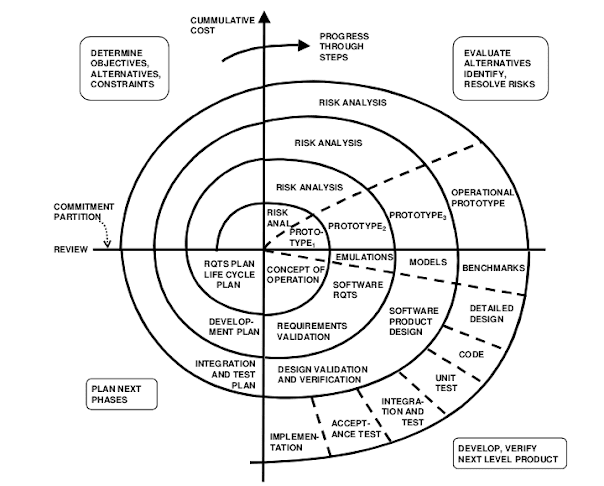Definition: The spiral model is similar to the incremental development for a system, with more emphasis placed on risk analysis. The spiral model has four phases: Planning, Design, Construct and Evaluation. A software project repeatedly passes through these phases in iterations (called Spirals in this model).
The spiral model is also known as the cyclic model.
The Spiral Model is widely used in the software industry as it is in sync with the natural development process of any product, i.e. learning with maturity which involves minimum risk for the customer as well as the development firms. When there is a budget constraint and risk evaluation is important.
1) Identification
This stage begins with collecting the feature requirements in the baseline spiral. In the ensuing spirals as the product evolves, the discovery of system requirements, components info, and unit-level inputs occur in this phase.
This stage also involves learning the system requirements by constant communication between the client and the system analyst. At the end of the spiral, the software gets deployed in the unique market.
2) Design
The Design phase begins with a basic thought of the mindmap in the first spiral and involves architectural design, logical layout of the modules, physical product prototype and the final design in the subsequent spirals.
3) Construction
The build stage refers to the production of the exact software product at every iteration. In the baseline cycle, when the software is just an idea of and the design is getting conceived as a prototype happens in this stage to learn client experience.
In the ensuing spirals with greater clarity on requirements and design specifications, a working copy of the software product known as build gets delivered with a proper version. It is then gets provided to the clients for their inputs.
4) Evaluation and Risk Analysis
Risk Analysis comprises classifying, measuring and observing the technical feasibility and business risks, such as schedule impact and cost escalations. After examining the build, at the end of the first repetition, the customer assesses the software and gives feedback
Spiral Model can be pretty costly to use and doesn't work well for small projects. It's a risk-driven model which means that the overall success of a project highly depends on the risks analysis phase. Thus, to review and analyze the project from time to time, special skills are needed.
Advantage and disadvantage of the spiral model.
Advantages | Disadvantages |
|
|
|
|
|
|
|
|
|
|


No comments:
Post a Comment